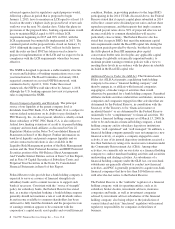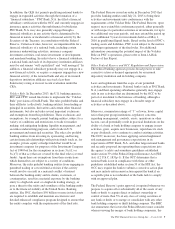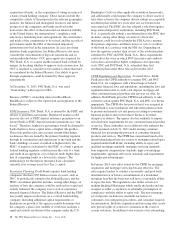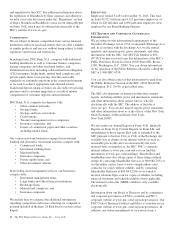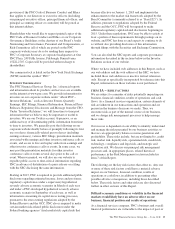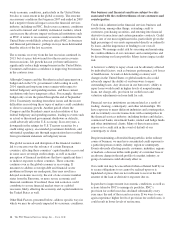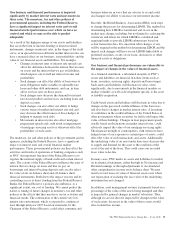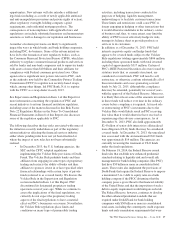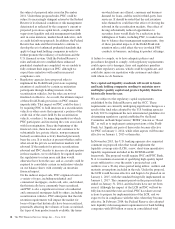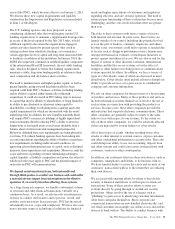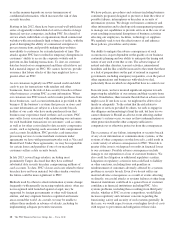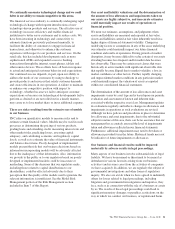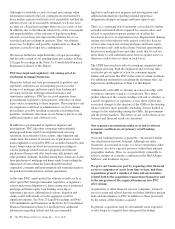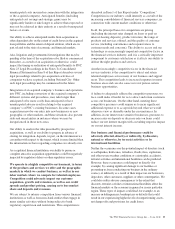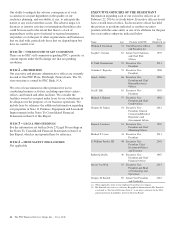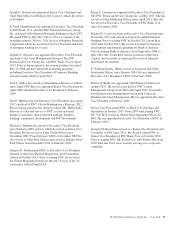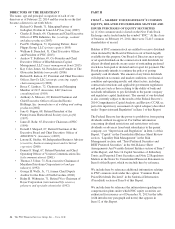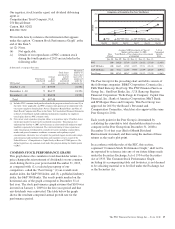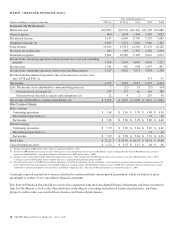PNC Bank 2013 Annual Report Download - page 36
Download and view the complete annual report
Please find page 36 of the 2013 PNC Bank annual report below. You can navigate through the pages in the report by either clicking on the pages listed below, or by using the keyword search tool below to find specific information within the annual report.the subject of proposed rules issued in December
2011. Under these proposed rules, PNC could be
subject to increasingly stringent actions by the Federal
Reserve if its financial condition or risk management
deteriorated as reflected by the company’s current or
projected post-stress capital levels, compliance with
supervisory liquidity and risk management standards
and, in some instances, market-based indicators, such
as credit default swap spreads. In addition, the Federal
Reserve has indicated that it intends to continue to
develop the set of enhanced prudential standards that
apply to large bank holding companies in order to
further promote the resiliency of such firms and the
U.S. financial system. Until the Federal Reserve’s
rules and initiatives to establish these enhanced
prudential standards are completed, we are unable to
fully estimate their impact on PNC, although we
expect these initiatives will result in increased
compliance costs.
• Regulatory agencies have proposed rules to
implement the Dodd-Frank provisions requiring
retention of credit risk by certain securitization
participants through holding interests in the
securitization vehicles, but the rules are not yet
finalized or effective. As a result, the ultimate impact
of these Dodd-Frank provisions on PNC remains
unpredictable. That impact on PNC could be direct,
by requiring PNC to hold interests in a securitization
vehicle or other assets that represent a portion of the
credit risk of the assets held by the securitization
vehicle, or indirect, by impacting markets in which
PNC participates and increasing the costs associated
with loan origination. Since the beginning of the
financial crisis, there has been and continues to be
substantially less private (that is, non-government
backed) securitization activity than had previously
been the case. It is unclear at present whether and to
what extent the private securitization markets will
rebound. If the markets for private securitizations
rebound and PNC decides to increase its participation
in those markets, we would likely be required under
the regulations to retain more risk than would
otherwise have been the case, and as a result could be
required to consolidate certain securitization vehicles
on our balance sheet, with currently an uncertain
financial impact.
On the indirect impact side, PNC originates loans of
a variety of types, including residential and
commercial mortgages, credit card, auto, and student,
that historically have commonly been securitized,
and PNC is also a significant servicer of residential
and commercial mortgages held by others, including
securitization vehicles. PNC anticipates that the risk
retention requirements will impact the market for
loans of types that historically have been securitized,
potentially affecting the volumes of loans securitized,
the types of loan products made available, the terms
on which loans are offered, consumer and business
demand for loans, and the need for third-party loan
servicers. It should be noted that the risk retention
rules themselves could have the effect of slowing the
rebound in the securitization markets. One effect of
having substantially reduced opportunities to
securitize loans would likely be a reduction in the
willingness of banks, including PNC, to make loans
due to balance sheet management requirements. Any
of these potential impacts of the Dodd-Frank risk
retention rules could affect the way in which PNC
conducts its business, including its product offerings.
A failure to comply, or to have adequate policies and
procedures designed to comply, with regulatory requirements
could expose us to damages, fines and regulatory penalties
and other regulatory actions, which could be significant, and
could also injure our reputation with customers and others
with whom we do business.
New capital and liquidity standards will result in banks
and bank holding companies needing to maintain more
and higher quality capital and greater liquidity than has
historically been the case.
We are subject to the regulatory capital requirements
established by the Federal Reserve and the OCC. These
requirements are currently undergoing significant changes as a
result of the final rules adopted by the U.S. banking agencies
in July 2013 to implement the new international guidelines for
determining regulatory capital established by the Basel
Committee on Bank Supervision (“BCBS”) known as “Basel
III,” as well as to implement certain provisions of the Dodd-
Frank Act. Significant parts of these rules became effective
for PNC on January 1, 2014, while other aspects will become
effective on January 1, 2015 or thereafter.
In November 2013, the U.S. banking agencies also requested
comment on proposed rules that would implement the
liquidity coverage ratio (LCR), a new, short-term quantitative
liquidity requirement included in the BCBS Basel III
framework. The proposal would require PNC and PNC Bank,
N.A. to maintain an amount of qualifying high-quality liquid
assets sufficient to cover the entity’s projected net cash
outflows over a 30-day stress period using inflow, outflow and
maturity assumptions included in the rule. Under the proposal,
the LCR would become effective and begin to be phased-in on
January 1, 2015, with the standard being fully implemented on
January 1, 2017. The comment period on the proposed rules
ended on January 31, 2014, and final rules have not yet been
issued. Although the impact of the LCR on PNC will not be
fully known until the rules are final, PNC has taken several
actions to prepare for implementation of the LCR, and we
expect to be in compliance with the rules when they become
effective. In February 2014, the Federal Reserve also adopted
new liquidity risk management requirements for bank holding
companies with $50 billion or more in consolidated total
18 The PNC Financial Services Group, Inc. – Form 10-K


